Star Trek II: The Wrath of Khan (1982)
Country USA
Director Nicholas Meyer
Running time 113 mins | Colour Movielab | Widescreen Panavision
Three years after its unexpected revival for the big screen in Star Trek: The Motion Picture in 1979, Star Trek delivered its first film sequel, Star Trek II: The Wrath of Khan, a film usually considered to be the best in the series and one of the highlights of the Star Trek canon.
Star Trek II: The Wrath of Khan brings back one of the best remembered antagonists from the original Star Trek TV series, Khan Noonien Singh (Ricardo Montalban), a genetically-engineered genius from the late 20th century. Khan and his crew were found in suspended animation on board their ship the Botany Bay in the TV episode "Space Seed". They attempted to take over the U.S.S. Enterprise, but were eventually foiled, and sent to settle the uninhabited planet of Ceti Alpha V.
15 years later and the Enterprise is now being commanded by Captain Spock (Leonard Nimoy) as a training ship. Among his crew are familiar faces, helmsman Sulu (George Takei), chief engineer Scott (James Doohan) and communications officer Uhura (Nichelle Nichols). Also temporarily on board is the ship's former commander, Admiral Kirk (William Shatner). He is visiting the ship on an inspection tour, having previously supervised some of the Star Fleet trainees in the simulator on the infamous Kobayashi Maru test.
Meanwhile, Pavel Chekov (Walter Koenig) is now serving on the U.S.S. Reliant, a ship assigned to a top secret project known as Genesis. Genesis is an experiment in terraforming barren planets to make them suitable for life. But in the wrong hands it could be used as a terrible weapon.
.jpg) |
| The familiar crew return in redesigned uniforms |
The planet they intend to use as a test is an apparently lifeless one, Ceti Alpha VI. But the Reliant's censors are picking up the tiniest signs of life. Chekov and the Reliant's Captain Terrell (Paul Winfield) beam down to investigate. As expected, they find a hostile, desert planet with little or no sign of life. But then they come across what appears to be a small settlement, a makeshift camp assembled from old cargo containers.
When they explore the interior they find that the equipment is from Khan's ship, the Botany Bay, a name that Chekov recognises, to his dismay. Before they can leave, the inhabitants return, led by Khan himself. Recognising Chekov, Khan explains that this planet is actually Ceti Alpha V, the other planet having been destroyed and this one turned by the resulting shockwave into a barren wasteland.
Khan is eager for revenge on Kirk for having stranded him on the planet, an environment now so hostile that most of his companions have died, including his own wife. He uses small parasitic creatures to control the minds of Chekov and Tyrrell, and through them is able to gain control of their ship the Reliant.
Learning of their work on Genesis, he also contacts Regula I, the space lab where scientists, including Kirk's old flame Carol Marcus (Bibi Besch) are working on the project, and has Chekov tell them that they will be collecting all materials on Genesis, on the orders of the Federation and Admiral Kirk.
Marcus contacts Kirk to protest, but the message is being jammed by Khan and, while Kirk can see and hear her, she is unable to hear him. Kirk decides to take the Enterprise, with its largely trainee crew, to investigate Regula I, a decision that will bring him head to head with his old foe Khan.
Despite a decidedly mixed reception and a reputation for being dull, slow moving and even boring, Star Trek: The Motion Picture had done reasonable business at the box office when it was released in 1979. But problems in producing the film's special effects caused its budget to triple to an eye-watering $44 million, around four times the cost of Star Wars, meaning that it wasn't the big money-making hit that had been hoped for.
It did seem clear, however, that there were enough Star Trek fans, both dedicated and casual, to make a second film a commercial proposition - as long as it was made on a greatly reduced and more realistic budget. Although it eventually slightly exceeded its budget, Star Trek II 's final production cost was reportedly around $13 million.
After the problems on the first film, Star Trek creator Gene Roddenberry, who had produced it, would not be directly involved. Instead, from this point onwards, the Star Trek films would see him credited as an "executive consultant", which meant that he was able to exert only a very limited influence over the direction of the film series.
Instead, Paramount turned to a television producer Harve Bennett and novelist-turned-screenwriter Nicholas Meyer to make the next film. Meyer had written the well-received Sherlock Holmes pastiche The Seven Per Cent Solution, also writing the screenplay for the subsequent 1976 film version. In 1979 he made his debut as writer and director on the time travel fantasy Time After Time, starring future Star Trek alumni Malcolm McDowell and David Warner.
Harve Bennett would remain an important influence on the Star Trek film series throughout the 1980s - even writing the screenplay for Star Trek III - but he brought in Robert Sallin, an old acquaintance from UCLA, for actual producing duties on The Wrath of Khan.
Bennett watched the original Star Trek TV series as preparation and selected Khan as a suitable antagonist for the film. Ricardo Montalban, who had mostly been working in television, especially on Fantasy Island, was signed to play the character once more.
Thanks in large part to the film, Khan became Star Trek's most memorable villain. Montalban's performance is certainly a full-blooded and melodramatic one. Despite the character's ruthlessness, he is not entirely unsympathetic, given his experiences since the crew of the Enterprise last encountered him. Montalban, though, mostly goes for the big effect, aided by his rich, resonant voice and the ability to play straight to the gallery.
 |
| New recruit Saavik (Kirstie Alley) with Admiral Kirk |
Although the second Star Trek film to be made, The Wrath of Khan is in effect the beginning of the familiar Trek film series, taking a dramatically different approach from its immediate predecessor. The style and tone of the series and the relationships between its central characters are established, or re-established, here after the more solemn and distant first film, which emphasised spectacular special effects mixed with sombre philosophising.
The original Star Trek characters and their relationships and interactions are captured much more successfully here than in the first film, where most of the characters were mere placeholders. Khan, meanwhile, offers a personal conflict with Kirk, instead of the depersonalised abstract one of the first film.
The film also introduced a new Vulcan character, Saavik, played by Kirstie Alley in her first film role. In some early drafts of the script this character was intended to be Spock's daughter. Paramount were unable to come to terms with Kirstie Alley for her appearance in the next film so the part was re-cast for Star Trek III.
Symbolically, the Star Fleet uniforms are re-designed. Bob Fletcher's pastel-coloured outfits of the first film were unpopular with the actors, so they were replaced for this film with a more military style that sees the cast re-dressed in matching burgundy tunics. Instead of different coloured uniforms for different specialisations (engineering, communications, medicine, etc), the specialisations are denoted by different coloured collars and tabs.
This more martial look is appropriate, as Star Trek II is much more militaristic than the previous film. Gene Rodenberry objected to this more military feel and so it was toned down a little, but the change from the first film is still quite apparent.
Star Trek II is also much more action-oriented, particularly with its space ship battles. This is in marked contrast to the first film, which culminated in the characters travelling very slowly through a giant electronic cloud while contemplating the mysteries of the universe.
The first two Star Trek films do represent differing ideas about what Star Trek actually is. For Gene Roddenberry, at least by 1979, it was about transhumanism and exploration, about humans expanding their consciousness and about lots and lots of talk. For Nicholas Meyer and his screenwriter Jack B. Sowards, it was about action, adventure, comradeship and foiling villains with diabolical schemes.
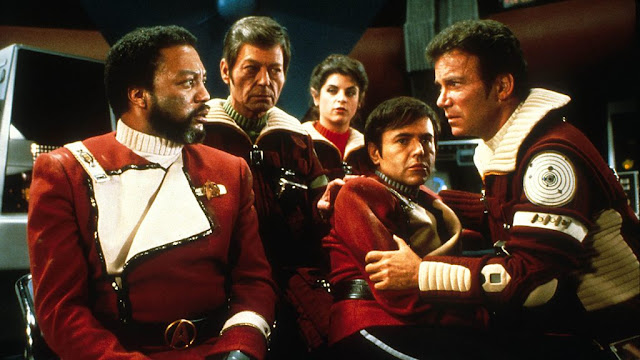 |
| Captain Terrell (Paul Winfield), Dr. McCoy (DeForest Kelley), Saavik (Kirstie Alley), Chekov (Walter Koenig) and Kirk (William Shatner) on Regula 1 |
Meyer described his approach to this film as making "Horatio Hornblower in space". And there is a sense that the film is a grand adventure, with the two ship's captains doing battle on the high seas. It's just that this is nominally science fiction, so the high seas have been replaced by outer space and the sailing ships by space ships.
This far greater orientation towards action is what makes Star Trek II a much more entertaining film than its predecessor. But to suggest that that's the only difference is to do it a disservice. Because the Wrath of Khan is the best Star Trek film, not simply because it's the most dramatic and entertaining, but because it's also the most layered and thoughtful, with some interesting themes. Unlike Star Trek: The Motion Picture, these themes are not sci-fi themes - they are about humans, not transhumanism.
Among the film's themes are revenge, obsession, the consequences of choices and mistakes made in the past, ageing and mortality and the facing of death - both your own and that of your friends. It's one of the strengths of the film's script that these themes emerge naturally from the characters themselves and are not simply imposed for plot expediency.
There are also additional character themes for Kirk. These are the repeated suggestions of downsides to his previously celebrated buccaneering spirit; his disregard for the rule book as well as his - and by implication the Star Trek TV series - tendency to continually move forward and not look back. These are unusual qualities to be perceived as negatives in a Hollywood film and in an heroic character. Who ever heard of a Hollywood hero who did everything by the rule book?
In Star Trek II Kirk's rule-breaking has disastrous consequences for the Enterprise, when he allows it to face the mysteriously uncommunicative Reliant without taking any defensive measures. He is even about to be reminded of the regulations by the trainee Saavik, but Spock cuts her off. The Admiral is well aware of the rules, he tells her. It's just that Spock, like the audience, knows that Kirk will ignore them anyway. Kirk's negligence results not only in serious damage to the Enterprise, but also in the deaths of many of his young crew in the subsequent action.
The story's implicit criticism of Kirk - that he continually looks forward and not back - is effectively a critique of Star Trek and of episodic television itself. Khan and his crew were stranded on a hostile planet because Kirk never thought to check to see how they had fared on Ceti Alpha V. He simply moved on to something else and forgot about them. The stated promise of Star Trek was, after all, to seek out "strange new worlds" - not go back to last week's planet and see how things are turning out.
Kirk even runs into a former lover, Carol Marcus, and their adult son that he barely knows. This is David (Merritt Butrick), a young scientist with the irritatingly preppy '80s habit of wandering around with his sweater tied around his neck. Kirk's old foes and former lovers, and the consequences of those relationships - positive and negative - are all around him in this film.
The film sets up its other key theme of ageing early on, with Dr. McCoy seen visiting Kirk at his home. There he is surrounded by his collection of antiques, in danger it seems of turning into one himself. McCoy's birthday gift to Kirk is a pair of antique spectacles, a visible sign of Kirk's ageing and declining faculties. In a nice touch later on, when Kirk first uses them to check a computer monitor, he removes them again before he can be seen by Khan, obviously initially reluctant to admit to this physical decline.
The film does suggest, though, that ageing is psychological as much as physical. In Kirk's case, this is because he has taken promotion instead of doing what he loves and is best at, commanding a star ship. Both McCoy and Spock argue that he was wrong to accept this promotion and a desk job on Earth.
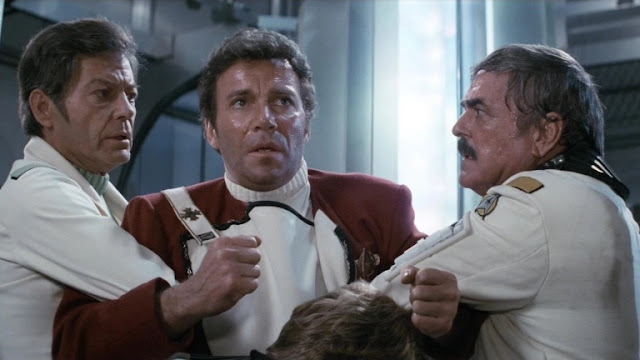 |
| Dr. McCoy (DeForest Kelley) and Scotty (James Doohan) hold Kirk back from the radiation-filled engine room |
This could also be seen as an implicit criticism of Star Trek: The Motion Picture and its decision to remove Kirk from his old role as captain of the Enterprise. His promotion to Admiral would have to be worked around (and eventually repudiated) in the subsequent films in the series, since promoting Kirk to such high rank made it more difficult to have him continually involved in outer space adventures.
The script foreshadows its plot developments and plants its themes early on in a way that's methodical and well considered, without ever making itself too obvious. Although it has to be said, the notion that one ship can order another to lower its defensive shields by inputting a special code in its own computer does seem like an unlikely plot contrivance.
Although the screenplay is credited to Jack B. Sowards, from a story by Sowards and Bennett, the film went through numerous script drafts and various hands were ultimately involved in the writing. The final version was apparently heavily re-written by Nicholas Meyer, incorporating different ideas from the various screenplays.
The film's numerous literary references are probably to be expected from this director and this is easily the most literate Star Trek film. These literary parallels are set up early on when Spock gives Kirk a birthday gift of a copy of Dickens' novel A Tale of Two Cities. Kirk reads the opening line, "It was the best of times, it was the worst of times" and later quotes approximately from the same novel, after a significant moment of sacrifice:
"It is a far, far better thing that I do, than I have ever done; it is a far, far better rest I go to than I have ever known."
Khan, meanwhile, is turned into the vengeful and obsessive Captain Ahab from Herman Melville's Moby Dick, a characterisation hinted at before we even meet him. This is when Chekov sees the novel on a shelf in Khan's quarters on Ceti Alpha V, before he spots the name of his ship Botany Bay on a piece of salvaged interior and decides to make a hasty exit.
This is also the film that introduces the now famous Kobayashi Maru test, a simulation of a rescue mission into Klingon territory designed to test Star Fleet cadets. The film's opening scene, with Lieutenant Saavik leading the Enterprise crew on a rescue mission, gets us straight into the action, but it also provides some surprises. These include apparent character deaths and a final revelation that it is all simply the Kobayashi Maru simulation at Star Fleet headquarters. As there had been rumours of a major character death in this film, this was partly intended to put the audience at ease by fooling them into thinking that this fake death scene was the actual one they had heard rumours about.
There is good use of sound in the film generally, but this is particularly noticeable in this scene, as Meyer builds tension from the constant beeps and hums of computer systems in the background, the crackling static of a distorted distress signal and computer voice warnings of approaching Klingon ships.
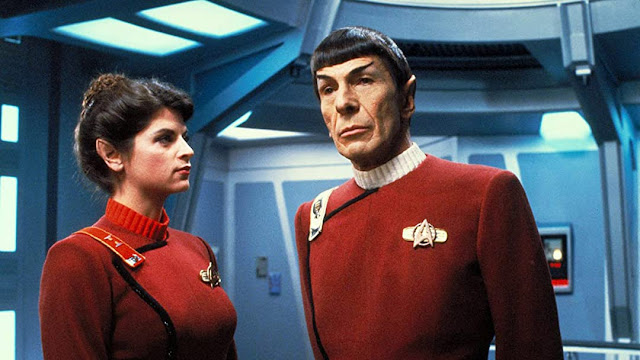 |
| Saavik (Kirstie Alley) with fellow Vulcan Spock (Leonard Nimoy) |
This scene also sets up the idea of a "no win" scenario, with Saavik arguing that the test is unfair. Kirk is quick to explain to her that real life and command will often mean facing such circumstances. As the film makes clear, however, Kirk himself has never done so, even cheating on the Kobayashi Maru test as a Star Fleet cadet by reprogramming the computer so that it could be beaten. He later explains that he in fact doesn't personally believe in no-win scenarios. But that's something the film is going to make him finally face before it's all over.
More unexpected are Star Trek II's horror elements. These are most apparent in the scenes when Khan uses parasites to control the minds of Chekov and Captain Terrel. They are the young of a creature referred to in other media as an eel, although it looks more like a crustacean. The moment they enter the victims' ears is shown in alarming close up, a disturbing scene for Star Trek and one straight out of horror cinema.
It's not entirely unique though, as The Wrath of Khan is a bit bloodier in general than you would expect for Star Trek. There is also a scene where Kirk, McCoy and Saavik explore the Regula I space lab, a deliberately tense sequence punctuated by a horror film jump scare, when one character bumps into a corpse dangling overhead.
Given the film's significantly reduced budget compared to its predecessor, Star Trek II doesn't compare on any level visually with the more grand and expansive first film. If anything, it looks a little dingy in comparison, with the use of cheaper Movielab colour giving the film a muddy look and a distinctly red hue.
This is accentuated by the deliberately gloomy lighting, as Nicholas Meyer obviously intended the film to have a darker aesthetic than had previously been the norm for Star Trek. Meyer wanted the bridge of the Enterprise to have a much more claustrophobic and enclosed feel, more like a submarine, and this is certainly the gloomiest the ship has ever looked. By the time the Enterprise is reduced to running on auxiliary power, the bridge is looking almost nocturnal.
Several of the special effects shots were reused from the first film in order to cut costs. These included the three Klingon ships seen at the beginning and the shuttle approach to the Enterprise when it's in space dock. New effects work for the film does include the first CGI sequence created for a feature film by Pixar. This is the computer animated simulation used to illustrate the terraforming effects of the Genesis device.
Nicholas Meyer was able to fight off an attempt to give the film a synthesizer score, in order to save money on hiring an orchestra. Instead he employed James Horner, who was then quite new to scoring films, having written the music for two 1980 Roger Corman productions, the schlock horror Humanoids from the Deep and sci-fi adventure Battle Beyond the Stars.
James Horner unexpectedly delivers Star Trek's second classic film score and, remarkably, manages to match and even exceed Jerry Goldsmith's score for the first film. In fact, this may even be Horner's best film score. His soaring title theme equals Goldsmith's march from The Motion Picture and is perfectly suited to this grand adventure. There's effectively creepy music for the scenes with Khan on Ceti Alpha V, and tense scoring for the battle scenes and the initial confrontation between Khan's ship and Kirk's.
Spoilers for Star Trek II are inevitable after all this time, but everyone must know by now that this film sees the death of a major Star Trek character - Mr. Spock - albeit temporarily. Spock's death was one of the early fixed points of the screenplay, Leonard Nimoy having grown tired of playing the part. But during filming he wavered and had second thoughts. This necessitated new scenes being shot, somewhat against the wishes of Nicholas Meyer.
These included a brief scene of Spock passing his "katra", or Vulcan consciousness, into McCoy's mind when he is unconscious in the ship's engine room, and a shot of the torpedo tube carrying Spock's body miraculously landing intact on the Genesis planet. This scene was shot by the film's producer Robert Sallin, not by Nicholas Meyer, in San Francisco's Golden Gate Park.
Spock's death scene, sacrificing himself to save the ship and its crew, is still moving, even though we now know that it was not exactly going to be permanent. His funeral scene is also well judged, with Scotty inevitably playing "Amazing Grace" on the bagpipes and Kirk briefly succumbing to his emotions during the final send off.
This did mean that the film set up a major problem for its successor to resolve, meaning that most of Star Trek III would be spent trying to undo the conclusion of Star Trek II.
The Wrath of Khan does have one reasonably well known continuity error and it's quite a big one. Khan recognises Chekov when they first meet, but Chekov was not in the "Space Seed" episode of the original series. Walter Koenig, of course, knew that he wasn't in that episode. But he was apparently so pleased with his more prominent role in this film that he decided not to remind anyone else of it and let the error pass without comment.
Star Trek II was originally intended to be subtitled "The Vengeance of Khan", which Meyer was unhappy with. He pointed out that the new Star Wars film, due the following year, was set to be called "Revenge of the Jedi" and so the title was changed to become The Wrath of Khan instead - although the Star Wars sequel was later retitled Return of the Jedi anyway. 70 mm prints and some tie-in merchandising apparently didn't include the Roman numerals in the title and so the film was also referred to in some places as Star Trek: The Wrath of Khan.
Meyer's preference had been for Star Trek II to be subtitled "The Undiscovered Country", a quote from Hamlet referring to death or the afterlife. He was eventually able to use this title when he returned to the series to direct Star Trek VI. For that film, it referred to the future and to peace between the Federation and the Klingons.
Although receipts were lower than for the first film, Star Trek II took just under $100 million at the box office worldwide and its greatly reduced budget meant that it was far more profitable than its predecessor.
Elements of The Wrath of Khan were used in both the J. J. Abrams Star Trek films in watered down form, when new actors were cast to play the younger versions of the familiar characters. The first of these, Star Trek in 2009, perhaps unwisely decided to show Kirk's cheating on the Kobayashi Maru test as a Star Fleet cadet. Even more unwisely, the plot and some scenes of The Wrath of Khan were rehashed in the second film, Star Trek Into Darkness in 2013, something that Nicholas Meyer called "absurd".
Star Trek II: The Wrath of Khan is certainly a far better film than its predecessor and it remains easily the best of all the Star Trek films. Its reputation has only grown over the years, especially as no subsequent Star Trek film has quite matched it. Nicholas Meyer would return to Star Trek to co-write Star Trek IV: The Voyage Home in 1986 and returned to the director's chair for the second best film in the series, and the last with the original cast, Star Trek VI: The Undiscovered Country in 1991.
Cast William Shatner (Admiral Kirk), Leonard Nimoy (Spock), DeForest Kelley (Dr. McCoy), James Doohan (Scotty), Ricardo Montalban (Khan), George Takei (Sulu), Walter Koenig (Chekov), Nichelle Nichols (Uhura), Bibi Besch (Carol Marcus), Merritt Butrick (David), Paul Winfield (Captain Terrell), Kirstie Alley (Saavik), Ike Eisenmann (Preston), John Vargas (Jedda), John Winston (Kyle), Paul Kent (Beach), Nicholas Guest (Cadet), Russell Takaki (Madison), Kevin Sullivan (March), Joel Marstan (Crew chief), Teresa E. Victor (Bridge voice), Dianne Harper (Radio voice), David Ruprecht (Radio voice), Marcy Vosburgh (Computer voice)
Producer Robert Sallin Executive producer Harve Bennett Cinematography Gayne Rescher Production designer Joseph R. Jennings Art director Michael Minor Editor William P. Dornisch Music James Horner Costume designer Bob Fletcher Special effects Industrial Light and Magic
Production company / Distributor Paramount Pictures
See also:
Star Trek: The Motion Picture
Star Trek III: The Search for Spock

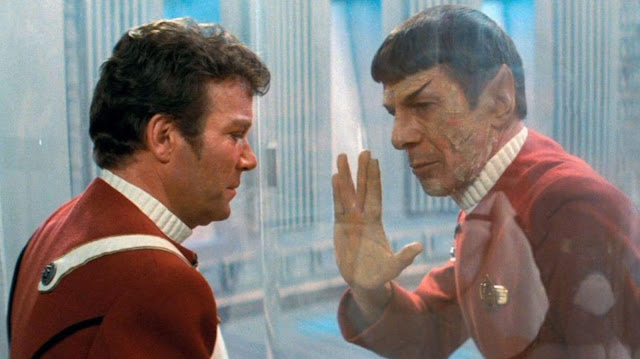

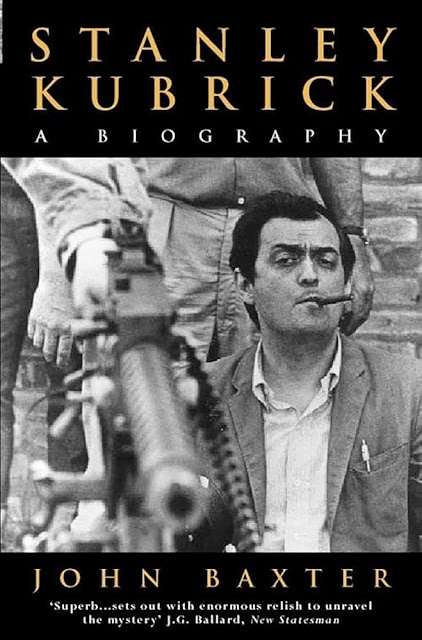
I was never a big Star Trek fan -- either of the show or the movies -- but I definitely remember seeing this one. I greatly enjoyed reading your post and remembering why I liked this movie -- and you've made me want to see it again!
ReplyDeleteI think this is one even non-fans can get behind. It's definitely the best in the series.
DeleteMontalban single-handedly saved the franchise. It's a magnificent performance! I love the moment he finds out Kirk is now an Admiral. Montalban says “Admiral” in three distinctively different ways: surprise, sadness, anger. And, like you said, he remains oddly sympathetic because the Federation did "forget to check his progress."
ReplyDeleteFrankly, I can't decide which Star Trek movie I like best, The Wrath of Khan, The Voyage Home or The Undiscovered Country. Maybe VI for sentimental reasons. But I do love all three movies.
I think Star Trek II is the best in the series, but VI is very good as well. The Voyage Home is much more entertaining than it should be, given that it verges almost into self-parody.
Delete